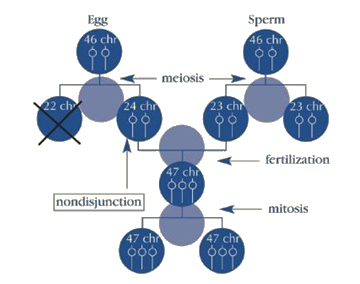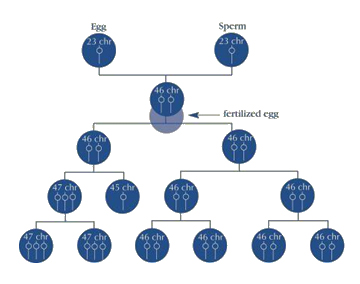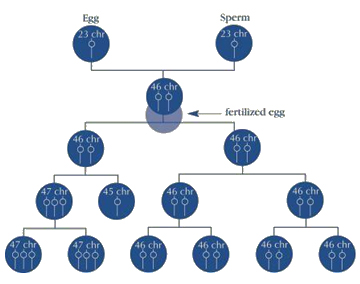
Down Syndrome is the effect of a chromosomal mutation. This disease doesn’t have much research, but does affect the lives of 1 in 700 people in the United States. Down Syndrome is also one of the most common chromosomal conditions.
Down Syndrome was first accurately published by John Langdon Down. He was published in 1866. He had been the one to give an accurate depiction of Down Syndrome. Years after in the year 2000 it was discovered that Chromosome 21 was the mutated gene.
Down Syndrome can be easy to depict in an individual. Most people with Down Syndrome have physical traits that will stand out, such as low muscle tone, upward slant to the eyes, and a single deep crease across the center of the palm. These are the most commonly known determiners, but each individual is different. Physical traits are sometimes determined by the three types of Down Syndrome. The three types of Down Syndrome are, Trisomy 21, Translocation, and Mosaic.
 |
Trisomy 21 (nondisjunction)Trisomy 21 occurs when there is an error in the the cell dividing. The cell has failed to separate Chromosome 21, causing nondisjunction. Trisomy 21 is the most common form of Down Syndrome and affects 95% of the people with Down Syndrome. |
"What Is Down Syndrome." National Down Syndrome Society. N.p., n.d. Web. 12 June 2017.
TranslocationTranslocation occurs in 4% of Down Syndrome cases. This mutation has 46 chromosomes, but the additional Chromosome 21, or partial Chromosome 21 attaches to another chromosomes. Research suggests that it most commonly attaches to chromosome 14, but is not limited to this chromosome. |
 |
"What Is Down Syndrome." National Down Syndrome Society. N.p., n.d. Web. 12 June 2017.
 |
MosaicMosaic Down Syndrome is the least common form. It only occurs in 1% of Down Syndrome cases. It gets its names because of the mixed nature of the Chromosomes the cells. In Mosaic some cells have the normal 46 chromosomes, and some have the mutation of 47. The cells that have 47 chromosomes have an extra chromosome 21. |
"What Is Down Syndrome." National Down Syndrome Society. N.p., n.d. Web. 12 June 2017.
Inevitably the cause of Down Syndrome comes down to the extra Chromosome 21. The current question is why this chromosome mutation occurs. From this brief description of Down Syndrome, you can see that there is still a lot of unknown information. It is important to raise awareness to what Down Syndrome is, and continue to further our knowledge on this condition. Below are links that provide additional information on the different types of Down Syndrome.
The DS design was created to help spread awareness about Down Syndrome. Alex wants the world to know what Down Syndrome is, and start raising funds for different Down Syndrome organizations. Funding for these programs are important for research, helping new families with Down Syndrome, and sharing Alex’s creative jewelry designs. Alex hopes to see all people wearing his DS design. He will donate a percentage of DS design proceeds to Down Syndrome Organizations to help the cause. Alex wants to use his passion to make a difference in the Down Syndrome community, and the world.
